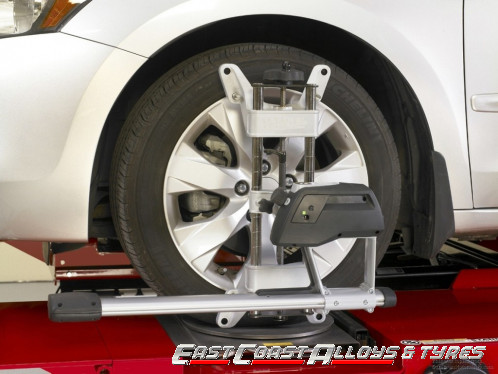Details

Regularly checking the alignment of the wheels on your car is essential for maintaining good handling and fuel economy, and reducing tyre wear. Our professional technicians use the latest 4 wheel alignment technology to assess and if necessary to correct the alignment of the wheels on your car.
Misaligned wheels can be indicated by:
- The vehicle pulls to one side
- The steering wheel is off-centred
- A 'woolly' feel to the steering
- Ghostly steering vibration, which can also indicate a loss of wheel balance
- Uneven tyre wear (see below).
The wheels on your car can become misaligned in the following ways:
Each type of misalignment leads to uneven wear on particular areas of the tyre, and it is possible for more than one type of misalignment to be the cause of the uneven wear.
Camber wear: camber is the angle of the plane of rotation of the wheel. Too much negative camber will evenly wear the inside edge of the tyre more than the outer edge, as the weight of the vehicle is acting more on this edge. Likewise, too much positive camber will evenly wear the outside edge of the tyre more than the inner edge.
Feathered / diagonal / heel and toe wear: the plane of rotation of the wheel should be in the direction of travel. If the wheels point inwards (‘toe in’), the outer edge of the tyre will scrape along the road, and the tyre will wear faster on this edge. Likewise, if the wheels point outwards (‘toe out’), the inner edge of the tyre scrapes along the road, and wears faster.
Other types of wear not related to misalignment are:

Inflation wear: if tyres are over-inflated they will bulge, and so the centre of the tread will wear faster than the outer edges. If tyres are under-inflated they cannot adequately support the weight of the vehicle over the whole width of the tread, and so more weight rests on the edges of the tread (which are supported by the sidewalls), leading to increased wear on the outer edges of the tyre. You should regularly check tyre pressures to ensure they are at the recommended pressure for the tyre, vehicle, and vehicle loading. Correct tyre pressures will maintain good handling and braking characteristics, and improve the vehicle’s fuel economy.
Chopped or spotty wear: this can be an indication that the shock absorber in the suspension has failed. Shock absorbers dampen the energy put into the suspension springs by the bumps in the road, so when they fail all the energy in the spring is returned through the tyre to the road. The tyre is unable to cope with so much energy bouncing it on the road, and will eventually fail as lumps come off the tread.
Local wear, bulges, and deep cuts: these can be an indication of damage to the structure of the tyre, perhaps through impact with a pothole or kerb, which has locally damaged the tread or the steel carcass of the tyre. If the rubber on the tyre has begun to perish and is cracking or separating this indicates that the tyre is old; tyres can age prematurely, depending on their use and storage conditions, for example. Persistent loss of tyre pressure also indicates damage or age. If a tyre is exhibiting any of these features it could unexpectedly fail, and should be checked by a technician and if necessary replaced.
Each tyre has a wear indicator built into it, which can help you to determine when the tread depth on the tyre has reached the legal minimum of 1.6 mm. When the tread of the tyre wears down to the same depth as the indicator the tyre should be replaced, however it is recommended that tyres are replaced before they reach the legal minimum. Driving a vehicle with tyres which have less than the legal tread depth could result in a fine and/or penalty points.

